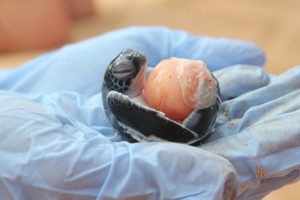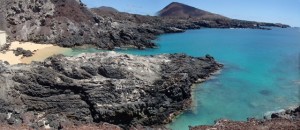“Managing Expectations” – that is Dr. Brendan Godley’s mantra during sea turtle research. This morning before beginning a nest excavation on Long Beach, he again warned to manage our expectations because there was a good chance we would not see any live hatchlings. To our utmost glee, this prediction was astoundingly wrong.
Dr. Sam Weber, a research fellow and one of the sea turtle conservation coordinators here on Ascension, led the excavation. As he dug in the first bucket, to our astonishment he scooped up heaps of hatchlings that were hiding just beneath the surface – one even went flying into the next nest pit! We all squealed with excitement and cameras clicked furiously. Not only did we get to see one hatchling, we got to see a whole bucketful of hatchlings!

The further Sam dug, the more little hatchling heads popped out of the sand, their frenzied crawl to the ocean commencing. Because it was daylight though, we kept every hatchling back and placed them in a bucket for a nighttime release (We got to release them too! More on that later…). The reasoning behind waiting is to avoid the hatchlings being easily predated by frigate birds or large tuna or sharks waiting in the water. By waiting until the dark of night to emerge, hatchlings decrease their chances of becoming dinner. Had we released them in the morning, they almost certainly would not have made it. Up against overwhelming odds, waiting until dark will increase their chance of survival.
A theme of this course is to reflect on the ecological roles sea turtles play in their ecosystems. While it is disheartening to think of undeveloped, predated, and dead hatchlings, these fates are all important ecological roles. Only about 30% of the energy transferred from the egg to the ecosystem actually comes in the form of a successful hatchling. Another 30% remains on the beach in the form of undeveloped eggs and the eggshells tossed back into the pit after excavation. These eggs/shells eventually decompose and deliver vital nutrients back into the sand. Another 30% is energy transferred to predators – also essential. Therefore, hatchling predation is a necessary part of ecosystem success.

After one joyous excavation and photo op, we attempted to manage our expectations as we dug for the second excavation. The purpose of these excavations is to collect data on clutch size and hatchling success. We recorded the number of hatched eggs, undeveloped egg yolks, and unhatched eggs with partial embryos, as well as measured the nest depth and location. Let me take a moment to point out that not only did we did get to do one excavation, but we only had to walk a mere 50 meters to start another. Not to mention navigating the endless body pits between the two – the density of nesting here is just unreal. But I digress… With the nest emerging 4 days ago we all expected to find no live hatchlings in the second nest, but alas, good sea turtle karma was on our side and we found another 10 or so live hatchlings! “Sea turtle utopia,” as Emily Cunningham, one of the conservation interns, calls it.

Around lunchtime, Christen and I actually ended up interviewing Emily (along with Brendan) for the short documentary we are making as our class project. The film will focus on conservation on Ascension Island and discuss the endemic land crabs, seabirds, and shrimp, and of course green turtles. We are very excited to share our visual stories of Ascension Island with everyone at MMISS at the Duke Marine Lab on March 28!
All week we have been begging to swim in the clear turquoise waters – we went swimming once at English Bay on Sunday, but being exhausted from hikes and late nights on the beach (rough life, we realize) Wendy and Matthew graciously agreed to take us today to Comfortless Cove. Its less than appealing name is a result of the fact that this is where those with yellow fever were sent for quarantine and essentially death – charming. With expectations again in check, I figured it would be similar to English Bay – again, I was tremendously wrong.

Teeming with black triggerfish, cichlids, snapper, grunts, wrasse, and various endemic fish I didn’t recognize, Comfortless Cove is the real paradise. The water is astoundingly clear, at the absolute perfect temperature for snorkeling to admire the endless fish and moray eel we spotted. We stayed only a few hours, but I believe all left feeling refreshed and eager to release the hatchlings that night!
The sunset hatchling release…where to even begin. First, on our walk to Long Beach we saw two different clans of the loveable feral donkeys that roam the island. One family was right on the beach and eager to sniff the bucket of hatchlings I had the honor to carry. Once they smelled the slightly rotten stench of the hatchlings, one donkey turned up his nose and wandered away. For as cute as they are, they can sometimes smell less than pleasant. After a quick photo op with the hatchlings, it was time to set them on the sand.

We all reverted back to children on the beach that night, urging the tiny turtles on in high-pitched excited voices. Most of them were less than eager to start their journey into the Atlantic and quite frankly I don’t blame them given the eager predators waiting in the water. But I have come to learn that we cannot cheer on species based entirely off their level of cuteness – every species has an important role to play. Despite their potentially unfavorable fate, we released a total of 52 green sea turtle hatchlings as the sun set on Long Beach. Today, like everyday so far, certainly exceeded our expectations.
